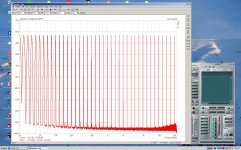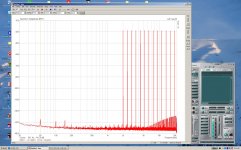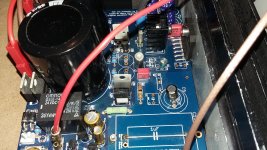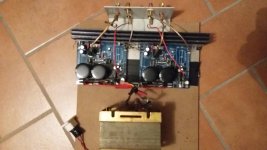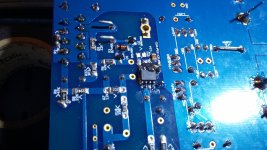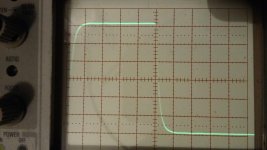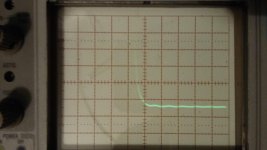Ok, and here are some other hopefully valid partecipants..
Here below is the OPA1642 in the FE board.
I hoped - hope in this chip (that is precisely the 1641, for the direct easy placement in the FE - Evo structure) because of the good sound that I found when trying it out as Dac output stage i a 4490 design.
Here below is the OPA1642 in the FE board.
I hoped - hope in this chip (that is precisely the 1641, for the direct easy placement in the FE - Evo structure) because of the good sound that I found when trying it out as Dac output stage i a 4490 design.
Attachments
-
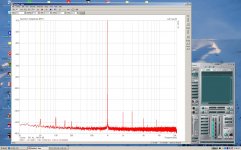 FE_OPA1642_-12db_44k_5W_1kHz_kulsotap_10mF_1_aug.jpg263.4 KB · Views: 278
FE_OPA1642_-12db_44k_5W_1kHz_kulsotap_10mF_1_aug.jpg263.4 KB · Views: 278 -
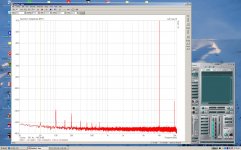 FE_OPA1642_-12db_44k_5W_10kHz_kulsotap_10mF_1_aug.jpg263.2 KB · Views: 265
FE_OPA1642_-12db_44k_5W_10kHz_kulsotap_10mF_1_aug.jpg263.2 KB · Views: 265 -
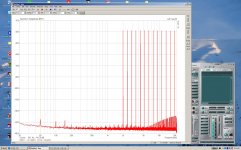 FE_OPA1642_-12db_44k_5W_high_multitone_kulsotap_10mF_1_aug.jpg286.3 KB · Views: 263
FE_OPA1642_-12db_44k_5W_high_multitone_kulsotap_10mF_1_aug.jpg286.3 KB · Views: 263 -
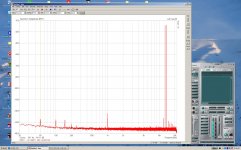 FE_OPA1642_-12db_44k_5W_IMD_13-14kHz_kulsotap_10mF_1_aug.jpg263.8 KB · Views: 256
FE_OPA1642_-12db_44k_5W_IMD_13-14kHz_kulsotap_10mF_1_aug.jpg263.8 KB · Views: 256
And here I would ike to stop for a second and 'meditate' about measurement methods..
In some other places in this forum one can see multitone testing applied (ok, it's childish, I'm talking about Tom's testing)
He likes it, discovered it ~recently, and boasts (rightfully) with his full spectra multitone test results..
http://www.diyaudio.com/forums/vend...r-achieving-0-0004-thd-n-212.html#post4682725
Now, why do I not like it? That is more precisely, I retain it to be not the most useful test, while certainly good for showing (nice) results?
Have a look at these to shots here below:
First is the same full scale multitone test signal what Tom is using;
Second is the short form of this, what I call high-multitone test signal, containing only the components above 2kHz.
In some other places in this forum one can see multitone testing applied (ok, it's childish, I'm talking about Tom's testing)
He likes it, discovered it ~recently, and boasts (rightfully) with his full spectra multitone test results..
http://www.diyaudio.com/forums/vend...r-achieving-0-0004-thd-n-212.html#post4682725
Now, why do I not like it? That is more precisely, I retain it to be not the most useful test, while certainly good for showing (nice) results?
Have a look at these to shots here below:
First is the same full scale multitone test signal what Tom is using;
Second is the short form of this, what I call high-multitone test signal, containing only the components above 2kHz.
Attachments
Indeed. There are surely some little advantages, but also some drawbacks. Not convincing at all.[...][OPA827]
Had I started with this replacement in the FE, maybe I would not have ended up here, talking about it..
On the other end, the ADA is simply another league... with it the FE made such a GIANT leap that it become a different, way much better sounding amp. Under every aspect.
I would not install the OPA827 on my own Evo... while I will definitely install the ADAs (well, unless the 1688 or some other suitable chip will prove to be at least as good in there).
perhaps a couple of days now... but no way, I don't like it at all. Forget about that one, it's not a good choice. At least not for Mauro's topology...
How much run-time on the OPA827?
Impressive measurements, Joseph! One question... Is there an explanation why there is significantly less mains hum in the ADA4627 measurements? Everywhere else it is clearly present, but ADA4627 measurements show only little remains of mains fundamental and its third harmonic...
Regards,
Oleg
Regards,
Oleg
Ok, I would jump back to the multitone testing for a a second:
In the second case, the one with the restricted bandwith, all the energy of the test signal is concentrated in the high frequency components;
Given that the test signal amplitude (rms) and so energy is given, limited, in my opinion the second, shorter test signal stresses much better the high frequency behaviour of the Dut, making the distortion components rise above the noise floor.
In the second case, the one with the restricted bandwith, all the energy of the test signal is concentrated in the high frequency components;
Given that the test signal amplitude (rms) and so energy is given, limited, in my opinion the second, shorter test signal stresses much better the high frequency behaviour of the Dut, making the distortion components rise above the noise floor.
Dear Oleg,
but also Spartacus;
Do not trust me too much with the power harmonics present in the testing;
It is not an easy task to arrive to these ~moderately clean looking shots, especially that I'm using single ended testing, and using the outputs/input of the same 'instrument', EMU1616m sound card.
So a big, unavoidable ground lop is formed in the test setup.
Without isolation transformers, or differential signalling one has to be extra careful about the exact topology in testing. Use of a shield for the DUT is obligatory. The way that the grounding of this shield is executed is important. Also, I'm using tricks for breaking the ground loop - but the effects are to be tested always.
Also the EMI radiation fields are incisive; the presence of the big transformers directly beside the DUT does not make it easier, to obtain a clean signal.
In the meantime if care is not taken, at 'this low' level of the distortion components injected / or not by these amplifiers it would be impossible to understand the results.
So, forgive me for some noise leaks, sometimes.
Would like to clarify though, that all these tests were executed in a very consistent way; the graphs to be compared were taken in the same setup configuration as much as possible, even if in the meantime I was also tweaking for less noise possible.
In the same time, what I can confirm is that the 'real' signal harmonics level and the noise floor are real different for the different DUTs.
but also Spartacus;
Do not trust me too much with the power harmonics present in the testing;
It is not an easy task to arrive to these ~moderately clean looking shots, especially that I'm using single ended testing, and using the outputs/input of the same 'instrument', EMU1616m sound card.
So a big, unavoidable ground lop is formed in the test setup.
Without isolation transformers, or differential signalling one has to be extra careful about the exact topology in testing. Use of a shield for the DUT is obligatory. The way that the grounding of this shield is executed is important. Also, I'm using tricks for breaking the ground loop - but the effects are to be tested always.
Also the EMI radiation fields are incisive; the presence of the big transformers directly beside the DUT does not make it easier, to obtain a clean signal.
In the meantime if care is not taken, at 'this low' level of the distortion components injected / or not by these amplifiers it would be impossible to understand the results.
So, forgive me for some noise leaks, sometimes.
Would like to clarify though, that all these tests were executed in a very consistent way; the graphs to be compared were taken in the same setup configuration as much as possible, even if in the meantime I was also tweaking for less noise possible.
In the same time, what I can confirm is that the 'real' signal harmonics level and the noise floor are real different for the different DUTs.
Rookie,
Sorry for not responding in time..
As about the ADA4898-1 -- yes, also I had found in a Dac output stage (as always, the 4490) that is very much notable..
For the record, I had found very good the OPA1612 (used for a long time); ADA4898-2 maybe even better;
OPA1642 (and probably OPA1662, too) was a very pleasant surprise;
All these are nice, neutral tonality devices, for me. Many times they are called 'boring' something that I don't understand..
But the doubtless winner in our Dac testing was.. the OPA1688, as output difference amplifier in that dac..
As You can see, this was the initiative why I had started to try for stability this particular family of devices, I mean the FET input amps.
Also, it seems that stabilizing the BJT input devices, which usually have a bit more 'tortured' inner compensation scheme, resulting in not so smooth gain/phase plots -- is a task more compelling, not impossible but will take time..
I mean the LME49990, for example, or the OPA1622, I have doubts about the ADA4898-1;
Also the OPA1611 / OPA211 gave problems;
To be noted finally, that instead the LME49710 seems to be a good fit, in the simulations. Maybe, will try also that. at last. and at least.. can not help, I also have antipathy problems, too..
Sorry for not responding in time..
As about the ADA4898-1 -- yes, also I had found in a Dac output stage (as always, the 4490) that is very much notable..
For the record, I had found very good the OPA1612 (used for a long time); ADA4898-2 maybe even better;
OPA1642 (and probably OPA1662, too) was a very pleasant surprise;
All these are nice, neutral tonality devices, for me. Many times they are called 'boring' something that I don't understand..
But the doubtless winner in our Dac testing was.. the OPA1688, as output difference amplifier in that dac..
As You can see, this was the initiative why I had started to try for stability this particular family of devices, I mean the FET input amps.
Also, it seems that stabilizing the BJT input devices, which usually have a bit more 'tortured' inner compensation scheme, resulting in not so smooth gain/phase plots -- is a task more compelling, not impossible but will take time..
I mean the LME49990, for example, or the OPA1622, I have doubts about the ADA4898-1;
Also the OPA1611 / OPA211 gave problems;
To be noted finally, that instead the LME49710 seems to be a good fit, in the simulations. Maybe, will try also that. at last. and at least.. can not help, I also have antipathy problems, too..
Last edited:
Dear Oleg,
but also Spartacus;
In the meantime if care is not taken, at 'this low' level of the distortion components injected / or not by these amplifiers it would be impossible to understand the results.
In the same time, what I can confirm is that the 'real' signal harmonics level and the noise floor are real different for the different DUTs.
Understood. Also, the results of your HF multi-tone testing are illuminating, maybe Tom will comment.
On another point, I'd be interested t see the results of class A biasing of the control op-amp. I've heard good results doing this with a CRD with the LME49990 and OPA827, even though distortion is already super low. My suspicion it's to do with either thermal modulation within the chip, and/or reduced modulation of the supply rail. But these are just guesses.
perhaps a couple of days now... but no way, I don't like it at all. Forget about that one, it's not a good choice. At least not for Mauro's topology...
You're not hearing the real thing then.... OPA827 changes A LOT with burn-in to the point the new one and the burnt-in seem two different opamps.
You will need 40-50 hours or at least 4-5 IsoTek passes.
On the other end, the ADA is simply another league... with it the FE made such a GIANT leap that it become a different, way much better sounding amp. Under every aspect.
I would not install the OPA827 on my own Evo... while I will definitely install the ADAs (well, unless the 1688 or some other suitable chip will prove to be at least as good in there).
No way... ADA4627 is a very good opamp, particularly the selected version but it's not better than OPA827, on the contrary I prefer TI's part which sounds better to my ears (after burn-in...when new is closed with sloppy bass).
Dario,
Yes, I'm on the third day, listening to the OPA827.
Otherways..
I'm quite much on your side.. But still has to admit - report that the ADA4627 did make a 'click' in the FE modul, and sounds in a truly beautiful way..
To say, it knocks on the tube SE territory, somehow.. I hate big words but this is the best description, from my part..
So much gain in the 3rd dimension, beautiful placement of the instruments, holografic, loads of space around. Surprisingly also the bass has gained a lot of control. Bass is usually a trifle less 'fundamental' in the FE modules than in the EVO..
Yes, I'm on the third day, listening to the OPA827.
Otherways..
I'm quite much on your side.. But still has to admit - report that the ADA4627 did make a 'click' in the FE modul, and sounds in a truly beautiful way..
To say, it knocks on the tube SE territory, somehow.. I hate big words but this is the best description, from my part..
So much gain in the 3rd dimension, beautiful placement of the instruments, holografic, loads of space around. Surprisingly also the bass has gained a lot of control. Bass is usually a trifle less 'fundamental' in the FE modules than in the EVO..
Attachments
So, the previous little note wanted to be the introduction to the final step, for me, in this testing:
Here it is the step response to the OPA1688.
Some work is needed, yet.. Which is a surprise, the simulation did not show it.
Here it is the step response to the OPA1688.
Some work is needed, yet.. Which is a surprise, the simulation did not show it.
Attachments
And here are the distortion tests.
OPA1688 in the FE module.
Comments: some surprises here..
As it was told before, the apparent noise levels in the graphs are pointing much more to me than to the devices.. still, especially in the multitone testing, the amount of fight to minimase the spuries presence in the ~ midrange/higher midrange frequencies -- is an experience which could be added to the tests like a 'parameter'
And while in case of the ADA4627 it was easy & almost first shot, in this case with this chip -- no way.
Also, one can notice the generally higher distortion figures. (1kHz tone, IMD test)
In the same time, the high frequency testing gave the lowest level ever seen up to now?! (10kHz)
And also in the multitone testing it is consequently low, the high frequency harmonics 'bush'..
It looks like if it were a chip with moderate open loop gain but with a high frequency corner..
Except for the fact that from the data sheets it is not.. Open loop gain has a 100Hz corner, at best?
OPA1688 in the FE module.
Comments: some surprises here..
As it was told before, the apparent noise levels in the graphs are pointing much more to me than to the devices.. still, especially in the multitone testing, the amount of fight to minimase the spuries presence in the ~ midrange/higher midrange frequencies -- is an experience which could be added to the tests like a 'parameter'
And while in case of the ADA4627 it was easy & almost first shot, in this case with this chip -- no way.
Also, one can notice the generally higher distortion figures. (1kHz tone, IMD test)
In the same time, the high frequency testing gave the lowest level ever seen up to now?! (10kHz)
And also in the multitone testing it is consequently low, the high frequency harmonics 'bush'..
It looks like if it were a chip with moderate open loop gain but with a high frequency corner..
Except for the fact that from the data sheets it is not.. Open loop gain has a 100Hz corner, at best?
Attachments
-
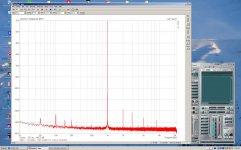 FE_OPA1688_-12db_44k_5W_1kHz_kulsotap_10mF_5_aug_2.jpg263.5 KB · Views: 309
FE_OPA1688_-12db_44k_5W_1kHz_kulsotap_10mF_5_aug_2.jpg263.5 KB · Views: 309 -
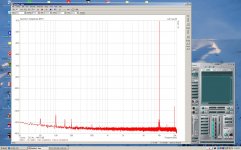 FE_OPA1688_-10db_44k_5W_10kHz_kulsotap_10mF_5_aug_2.jpg262.3 KB · Views: 298
FE_OPA1688_-10db_44k_5W_10kHz_kulsotap_10mF_5_aug_2.jpg262.3 KB · Views: 298 -
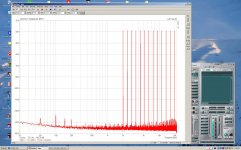 FE_OPA1688_-12db_44k_5W_high_multitone_kulsotap_10mF_1_aug.jpg288.7 KB · Views: 71
FE_OPA1688_-12db_44k_5W_high_multitone_kulsotap_10mF_1_aug.jpg288.7 KB · Views: 71 -
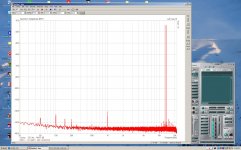 FE_OPA1688_-13db_44k_5W_IMD_13-14kHz_kulsotap_10mF_5_aug.jpg268 KB · Views: 69
FE_OPA1688_-13db_44k_5W_IMD_13-14kHz_kulsotap_10mF_5_aug.jpg268 KB · Views: 69
Last edited:
Yes, I'm on the third day, listening to the OPA827.
Otherways..
I'm quite much on your side.. But still has to admit - report that the ADA4627 did make a 'click' in the FE modul, and sounds in a truly beautiful way..
Seeing the modules I understand better previous comments and I must warn you... be carefull... there are multiple components which have been replaced in BOM for their coloration and that could somewhat spoil listening tests.
The Panasonic TS-HA are the biggest problem, followed by the NCC LZX, both have strong colorations in the midrange.
If you want to seriously select a 'best sounding' alternate opamp you should use boards with a better balanced BOM, IMHO.
Dario,
this is the point exactly..
That module, with that component list, is besting the other amp, at this moment..

For sure I will continue on, first of all using of the latest version FE.
But, You should also note the presence of your's precious compensation caps, the BG in the feedback etc.. So there are elements in that little module which are giving helpin hand..
this is the point exactly..
That module, with that component list, is besting the other amp, at this moment..
For sure I will continue on, first of all using of the latest version FE.
But, You should also note the presence of your's precious compensation caps, the BG in the feedback etc.. So there are elements in that little module which are giving helpin hand..
this is the point exactly..
That module, with that component list, is besting the other amp, at this moment..
I've undestood that but what I'm warning about is that the strong colorations of some of the parts used could be misleading in the opamp choice.
NCC LZX for example, while wonderfully precise and clean will also have a magnifying effect on midrange and soundstage.
Even a small difference in the midrange will be magnified while in a real FE with latest BOM that difference could be detrimental or even not heard.
To select the best alternate opamp you should want/need the most neutral/transparent BOM (which should include z-foils, ideally)
But, You should also note the presence of your's precious compensation caps, the BG in the feedback etc.. So there are elements in that little module which are giving helpin hand..
I've noted it but they can't nothing for the dreadfull TS-HA...
And the BG could be detrimental in this context since it 'polishes' sound a bit and so it could mask some problems.
Dario, thanks for the links on the prior page describing the parts for the EVO mod of your MyRef but I was hoping for a discussion about the compensation and why it improves the measurements. I was planning to do the EVO mods on the original Mauro MyRef_C.
I fear that for it you should contact the original designer, Mauro Penasa.
You can use the My_Evo Rev A compensation also on the original My_Ref but you will need to replace also C34 with a 27pF cap (C0G or better silver mica).
You should also replace R42 with a wire and (optional) re-route LM3886 ground pin to power ground.
Last edited:
Dario,
Wanted to report on this: it seems very much like You were right about burn-in time for the OPA827 in the EVO amp.
It sounds gorgeous. Rich, warm but precise and with source (dac, signal and supply cables ) scaling upwards it keeps gaining more and more musicality..
(We had some listening sessions yesterday)
The change from the lm318 is gradual, though. I would like to emphatise that it is not night and day, and the classic configuration is no slouch as well..
Still, i would be happy if you could try it, too. We can discuss the details if you wish.
This opamp could be an interesting alternative. Apart from the ADA4627..which still perform very good in the FE. But for a real comparison it should be in the same amp. Duh.. I would like to be careful about changing too easily parts in the EVO amp. The board is not that robust like your modules..
Wanted to report on this: it seems very much like You were right about burn-in time for the OPA827 in the EVO amp.
It sounds gorgeous. Rich, warm but precise and with source (dac, signal and supply cables ) scaling upwards it keeps gaining more and more musicality..
(We had some listening sessions yesterday)
The change from the lm318 is gradual, though. I would like to emphatise that it is not night and day, and the classic configuration is no slouch as well..
Still, i would be happy if you could try it, too. We can discuss the details if you wish.
This opamp could be an interesting alternative. Apart from the ADA4627..which still perform very good in the FE. But for a real comparison it should be in the same amp. Duh.. I would like to be careful about changing too easily parts in the EVO amp. The board is not that robust like your modules..
Wanted to report on this: it seems very much like You were right about burn-in time for the OPA827 in the EVO amp.
It sounds gorgeous. Rich, warm but precise and with source (dac, signal and supply cables ) scaling upwards it keeps gaining more and more musicality..
(We had some listening sessions yesterday)
Absolutely, being unable to do to on the FE, I've made this experience on DACs.The change from the lm318 is gradual, though. I would like to emphatise that it is not night and day, and the classic configuration is no slouch as well..
LM318 sounds incredibly good with plenty of details, big soundstage and incredibly musical despite its age and questionable (today) input stage.
Modern opamps adds clarity and a bit of detail but can hardly match its musicality.
OPA827 is one the few it does.
I'm curious too but I have to find first a smart way of doing it... I need fast switch times.Still, i would be happy if you could try it, too. We can discuss the details if you wish.
Don't mess too much with My_Evo boards, remember they're gone forever...use FE ones to experimentDuh.. I would like to be careful about changing too easily parts in the EVO amp. The board is not that robust like your modules..
- Home
- Amplifiers
- Chip Amps
- My_Ref Fremen Edition - Build thread and tutorial
